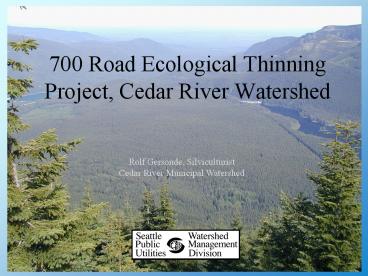700 Road Ecological Thinning Project, Cedar River Watershed - PowerPoint PPT Presentation
1 / 23
Title: 700 Road Ecological Thinning Project, Cedar River Watershed
1
700 Road Ecological Thinning Project, Cedar River
Watershed
Rolf Gersonde, Silviculturist Cedar River
Municipal Watershed
2
Seattle Public Utilities Cedar and Tolt
Municipal Watershed
3
Key Features of SPU-HCP (2000)
Bull trout
- Safe and secure water supply
- 50-year term
- Ecological reserve
- Restoration commitments
- Roads, streams, riparian and upland forests
Common loon
Chinook
Spotted owl
4
Forest Restoration Goals
- LSF Conditions
- Tree size
- Spatially clumped
- Foliage height diversity
- Decadence
- Ecosystem Functions
- Biological Diversity
- Ecosystem Resilience
5
700 Rd Project Location in the CRW
6
700 Road Ecological Thinning Project (2004)
Species WH, DF, RC, SF, RA Structure 65 year
single cohort, BA 210-360 sqft/ac QMD 9.3
14.3 SDI 400 - 620
7
Stakeholder involvement processComments at
Ecological Thinning Workshop (7/18/2004)
- Prescriptions are too conservative. You should
experiment with thinning more heavily. - Prescriptions not conservative enough they
should be limited to never cutting any big
trees. - You dont need to experiment. You can learn from
what other landowners have done. - Second-growth forests created from clearcutting
are on natural trajectories and dont need
intervention. - There is more wildlife in my back yard than I
have seen in the second growth in the watershed. - You need to create openings to provide habitat
diversity and support wildlife. - We need to know exactly how any money made from
sale of trees will be used.
8
Stakeholder involvement processSummary of changes
- Reduce area to be ecologically thinned
- Reduce number of acres where trees will be yarded
- Create numerous variably-shaped small gaps and
skips - Create Unit E9 at the top of the ridge
- Add variable sized skips around existing unique
habitat features - Increase basal area targets
- Lower diameter limit for cutting
9
700 Road Ecological Thinning Project (2006)
Treatments 230 ac. Thinning with Skips and
gaps 120 ac. Cut and Leave Reserve areas
10
Structure type ratio by treatment unit
11
Scales of Variability Thinning-pool spacing
with skips and gaps 700 Rd
- Unit E1a
12
Diameter distribution by species Differentiation
into crown and size classes Thinning pool varies
by species, create bimodal distribution
13
Example of thinning prescription (E1)
14
Structural FeaturesLarge skip and
gap Thinned matrix
15
Conceptual layout of thinning Unit E6
16
Effect of canopy density on understory light
environment
Stand Visualization System
tRAYci Light Model
17
Distribution of light intensity at different
stand densities
18
Wind Disturbance Regime
Topex Jean-Claude Ruel, Steve Mitchell, and Naa
Lanquaye-Opoku
19
Effect of tree position relative to gap edge on
diameter growth and average crown width
Graph shows median and quartiles, data are taken
from mature Douglas-fir stand at CRMW diameter
increments are significantly different at
p0.032 average crown width are significantly
different at p0.0004.
20
Disaggregated growth modeling in FVS
21
Down wood volumes
11 ground cover, 45 tons or 6000 bf/ac on 120
acres 80 of average westside conifer-hardwood
forests (Ohmann and Waddell 2002)
22
Contractual Issues
Surplus timber production (2.5 mmbf) requires
approval from City Counsel (ordinance)FSC
Certification (2006)Request for
ProposalLong-term relationship with
contractorsOperator Certification
AR Cable Thinning
23
Forest Restoration Uncertainties
- Understory response
- Effect of CWD on understory developement
- Proportion of structure types
- Gap size/diversity
- Maintaining growth rates
- Disturbance interactions

